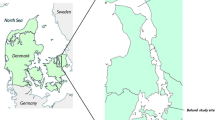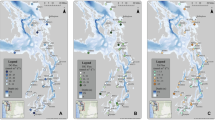Abstract
The determination of adenosine triphosphate (ATP), adenosine diphosphate (ADP), and adenosine monophosphate (AMP) concentrations in sediments from both Puget Sound and the Washington State continental shelf (USA) has been investigated. Major losses during the extraction procedure included sediment sorption, coprecipitation, and unreactivity of the soluble adenylates presumably through irreversible binding to solubilized sediment organics. Addition of phosphoric acid and the non-ionic detergent Triton X-100 to cold sulfuric acid significantly increased the extraction efficiency and sensitivity over that of sulfuric acid alone, although both methods yielded similar results when corrected for losses. Vertical profiles of ATP, total adenylates (AT), and adenylate energy charge (EC) in sediments from both areas are presented. Profiles of AT are similar in both areas, but EC values in the shelf sediments are significantly lower, which suggests a depressed physiological condition in the shelf population relative to that in Puget Sound.
Similar content being viewed by others
Literature Cited
Anderson, G. C.: Aspects of marine phytoplankton studies near the Columbia River with special reference to a subsurface chlorophyll maximum.In: The Columbia River estuary and adjacent ocean waters, pp 219–240. Ed. by A. T. Pruter and D. L. Alverson. Seattle: University of Washington Press 1972
Atkinson, D. E. and G. M. Walton: Adenosine triphosphate conservation in metabolic regulation. Rat liver citrate cleavage enzyme. J. biol. Chem.242, 3239–3241 (1967)
Bulleid, N. C.: An improved method for the extraction of adenosine triphosphate from marine sediment and seawater. Limnol. Oceanogr,23, 174–178 (1978)
Chapman, A. G. and D. E. Atkinson: Adenine nucleotide concentrations and turnover rates. Their correlation with biological activity in bacteria and yeast. Adv. microb. Ecol.15, 253–306 (1977)
Chapman, A. G., L. Fall and D. E. Atkinson: Adenylate energy charge inEscherichia coli during growth and starvation. J. Bact.108, 1072–1086 (1971)
Christensen, J. P., T. G. Owens, A. H. Devol and T. T. Packard: Respiration and physiological state in marine bacteria. Mar. Biol.55, 267–276 (1980)
Cunningham, H. W. and R. G. Wetzel: Fulvic acid interferences on ATP determinations in sediments. Limnol. Oceanogr.23, 166–173 (1978)
Eiland, F. and B. S. Nielsen: Influence of cation content on adenosine triphosphate determinations in soil. Microb. Ecol.5, 129–137 (1979)
Ernst, W.: ATP als Indikator für die Biomasse mariner Sedimente. Oecologia (Berl.)5, 55–60 (1970)
Ferguson, R. L. and M. B. Murdoch: On the estimation of microbial ATP in estuarine sediments and water. Bull. ecol. Soc. Am.54, p. 27 (1973)
Hedges, J. I. and D. C. Mann: The lignin geochemistry of marine sediments from the southern Washington coast. Geochim. cosmochim. Acta43, 1809–1818 (1979)
Hodson, R. E., O. Holm-Hansen and F. Azam: Improved methodology for ATP determination in marine environments. Mar. Biol.34, 143–149 (1976)
Holm-Hansen, O.: Determination of total microbial biomass by measurement of adenosine triphosphate.In: Estuarine microbial ecology, pp 73–89. Ed. by L. H. Stevenson and R. R. Colwell. Columbia, S.C.: University of South Carolina Press 1973
Karl, D. M.: Distribution, abundance and metabolic states of microorganisms in the water column and sediments of the Black Sea. Limnol. Oceanogr.23, 936–949 (1978)
Karl, D. M., J. A. Haugness, L. Campbell and O. Holm-Hansen: Adenine nucleotide extraction from multicellular organisms and beach sand: ATP recovery, energy charge ratios and determination of carbon/ATP ratios. J. exp. mar. Biol. Ecol.34, 163–181 (1978)
Karl, D. M., and O. Holm-Hansen: Methodology and measurement of adenylate energy charge ratios in environmental samples. Mar. Biol.48, 185–197 (1978)
Karl, D. M., and P. A. LaRock: Adenosine triphosphate measurements in soil and marine sediments. J. Fish. Res. Bd Can.32, 599–607 (1975)
Karl, D. M., P. A. LaRock, J. W. Morse and W. Sturges: Adenosine triphosphate in the North Atlantic Ocean and its relationship to the oxygen minimum. Deep-Sea Res.23, 81–88 (1976)
Lundin, A. and A. Thore. Comparison of methods for extraction of bacterial adenine nucleotides determined by firefly assay. Appl. Microbiol.30, 713–721 (1975)
Pamatmat, M. M.: Oxygen consumption by the seabed. IV. shipboard and laboratory experiments. Limnol. Oceanogr.16, 536–550 (1971a)
Pamatmat, M. M.: Oxygen consumption by the seabed. VI. Seasonal cycle of chemical oxidation and respiration in Puget Sound. Int. Revue ges. Hydrobiol.56, 769–793 (1971b)
Pamatmat, M. M.: Benthic community metabolism on the continental terrace and in the deep sea in the North Pacific. Int. Revue ges. Hydrobiol.58, 345–368 (1973)
Pradet, A.: Etude des adénosine-5′-mono, di et triphosphates dans les tissus végétaux. I. Dosage enzymatique. Physiologie vég.5, 209–221 (1967)
Tobin, R. S., J. F. Ryan and B. K. Afghan: An improved method for the determination of adenosine triphosphate in environmental samples. Wat. Res.12, 783–792 (1978)
Wiebe, W. J. and K. Bancroft: Use of the adenylate energy charge ratio to measure growth state of natural microbial communities. Proc. natn. Acad. Sci. U.S.A.72, 2112–2115 (1975)
Winter, D. F., K. Banse and G. C. Anderson: The dynamics of phytoplankton blooms in Puget Sound, a fjord in the northwestern United States. Mar. Biol.29, 139–176 (1975)
Author information
Authors and Affiliations
Additional information
Communicated by N. D. Holland, La Jolla
Contribution No. 513 from the University of Washington's College of Fisheries, and Contribution No. 1135 from the University of Washington's Department of Oceanography
Rights and permissions
About this article
Cite this article
Christensen, J.P., Devol, A.H. Adenosine triphosphate and adenylate energy charge in marine sediments. Mar. Biol. 56, 175–182 (1980). https://doi.org/10.1007/BF00645341
Accepted:
Issue Date:
DOI: https://doi.org/10.1007/BF00645341




